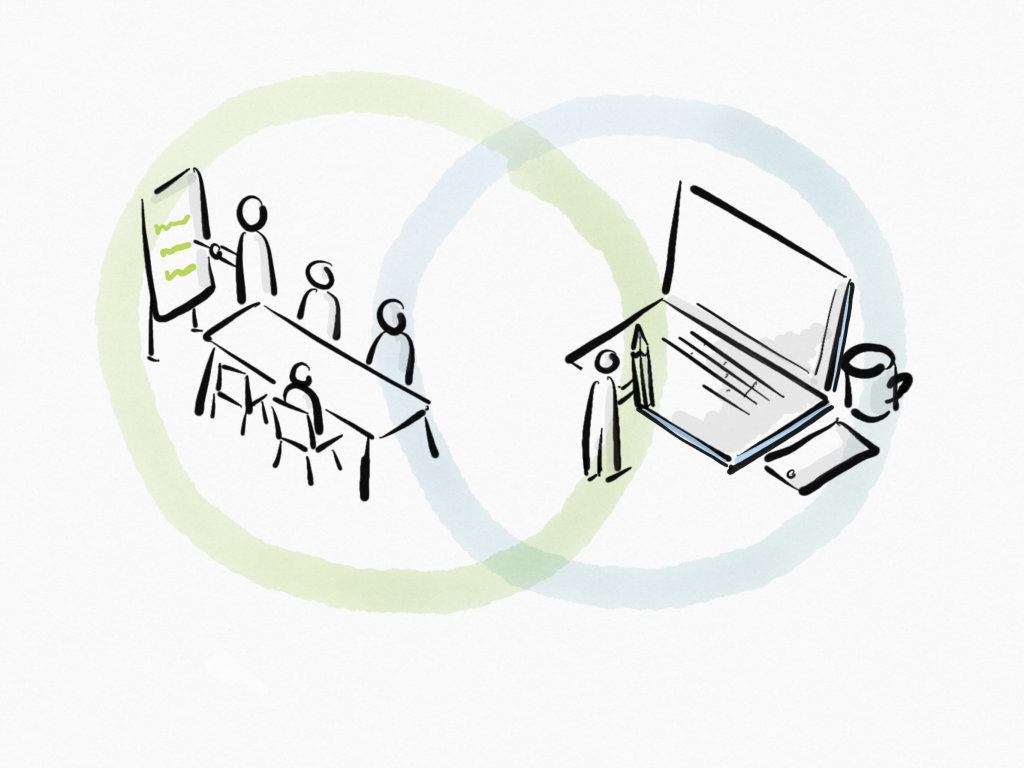The best of both worlds
Over the past year, the current Corona pandemic has time and again challenged us to develop and try out new, digital learning formats. Yet the classic face-to-face seminar also comes with certain advantages in education and training. How can classroom seminars be best intertwined with digital elements? One versatile option is the format of blended learning.
By blended learning we refer to learning formats in which we connect learning through electronic media with attendance learning in a didactically meaningful manner. We blend the best ingredients from both worlds in a shaker and create a learning mix that offers many advantages: The aim is to combine group learning and on-site exchange with the possibilities of digital media and technologies for self-guided learning in a purposeful way.
Why blended learning?
On the one hand, the advantages of e-learning come into play: learners can work through and repeat content flexibly, independent of working hours and at their own (learning) pace. Especially in adult education, where the actual job and one’s own life circumstances require flexibility, this is an advantage and can contribute to the success of a training.
On the other hand, purely digital learning offers are often not accepted by learners as hoped if the personal connection to the teacher and fellow learners is missing. This is where the advantages of face-to-face sessions come into play. Through individual support and personal communication, we strengthen motivation.
How should I approach it?
There are many blended learning formats, and what is right for you depends on resources, target group, learning objectives and content. Think about what you want to achieve and for which content you need personal exchange. Which lessons are suitable for working through independently?
Here is an example:
Within a longer training course, a content block with the difficult topic of data protection is planned and a legal expert is available in the face-to-face event who provides professional expertise. In this case, it would be a pity if the valuable attendance time were wasted with a frontal lecture with a basic introduction. Instead, an online phase was used beforehand to make the intended content available to the participants digitally in the form of video, audio and text.
This way, the participants independently acquire basic knowledge in advance and at their own pace, bringing with them a more uniform prior knowledge, and in the face-to-face seminar there is room for valuable collaborative, interactive repetition, consolidation, application and discussion of the content, together with the expert. In other cases, it makes sense to first give a joint introduction in presence and then make the in-depth tasks and materials available online.
For a blended learning format to work purposefully, it requires a clear goal. The following questions can help:
- Do I want to provide in-depth materials in the online phase or provide an introduction to the topic?
- Do I want to use the online phase to accompany the transfer into practice or is a face-to-face workshop better suited for this?
- Is a simple combination of online and face-to-face sufficient or do I want to develop complex online courses?
Examples of different blended learning settings are given by Dr. Katja Bett and Konrad Fassnacht in a clear summary on The blended learning formula webinars + e-learning + presence.
And in implementation?
Once the didactic considerations have been defined, it’s time for implementation. Here are some tips from practical experience that can help you:
1. Choose your tools well
If you’re thinking of big learning platforms such as Moodle and the like, you’re right, but even if you don’t have such a powerful learning management system at hand, you can help yourself with a few smaller tools.
To design your online phases, collaboration and chat tools such as slack or the alternative RocketChat, which is compliant with data protection, are sufficient at the beginning. You can use these to exchange files so that you can provide tasks and materials during the online phase and learners can upload their assignments. It is also an easy way to keep in touch and be reachable for questions. Learners will also be able to network with each other. In addition, a video conferencing tool is a handy extra in case your classroom event cannot take place at the venue. That way you can switch to a digital room instead. The REFAK Blog already provides numerous tips for successful webinars, among others under “Everyone aboard the Online-Express?” (“Alle dabei im Online-Express?”) and in the testimonial: Three days of BigBlueButton (Drei Tage BigBlueButton).
It is also useful to work with an Etherpad where participants can collaborate. This also serves to create a spirit of belonging during the online phase and can facilitate networking among participants. There are plenty of additional online tools you can use, such as Padlets, Flinga etc. First, though, concentrate on what is most useful for you, according to the motto “less is more”.
2. Get everyone on board
Working with digital tools requires a certain degree of digital competence on the part of the learners. It is therefore important to get everyone on board right from the outset so that nobody gets lost along the way, particularly during the self-paced online phases.
Therefore, it is crucial to introduce tools in detail before diving into the content. For example, you can do a prior technology check with the video conference system or start a short chat in which everyone writes a few words. Short, simple explanatory videos on the tools can also be helpful to overcome technical obstacles.
3. Make structure and processes clear
It may sound logical, but it is essential, especially in larger blended learning formats, to keep all steps transparent. For this purpose, also use the attendance phases to review the last online phase and to give an outlook on the next phase. That way, you make certain that both worlds are intertwined and the next steps are perfectly clear for the learners. Also set fixed deadlines for assignments.
4. Create motivating online content
Since your participants learn in a self-organised way during the online phases, the content and tasks need to be presented in a comprehensible and appealing manner so that motivation is upheld. Of course, you are not limited to text-only content. Learning videos, podcasts or quizzes are also ways to package content in an interesting format.
5. Support between classroom sessions
Make it clear that you are available for questions and support during the online phase. It doesn’t matter whether it’s via a clearly conveyed contact email address, a question forum or directly via chat. It is important that you can provide solutions and answers promptly to avoid losing participants.
Conclusion:
On the one hand, blended learning offers a lot of support for the learners, but also a lot of self-determination if you know how to mix the content up properly. However, it pays to be careful when it comes to the amount of work required. The fact that part of the content is digital does not necessarily mean less work for the participants, and also requires self-discipline. With clear advance communication about the workload, blended learning can be a good way to mesh online and face-to-face learning well and combine the merits of both worlds.
Outlook:
In the next #dido we will look at another way of dovetailing online and face-to-face, which is in hybrid events, when some of the people are not on site in the room.
Author: Katharina Nierhoff
Lust auf mehr? Zu allen Beiträgen der Serie kommst du HIER!

Dieses Werk ist lizenziert unter einer Creative Commons Namensnennung-NichtKommerziell-Weitergabe unter gleichen Bedingungen unter gleichen Bedingungen 3.0 Österreich Lizenz.
Volltext der Lizenz






